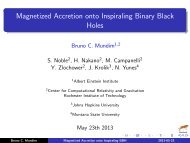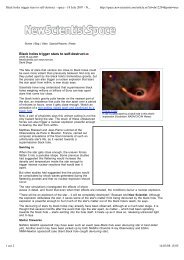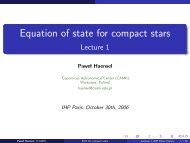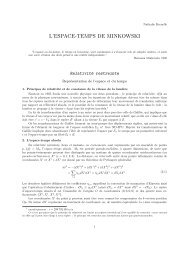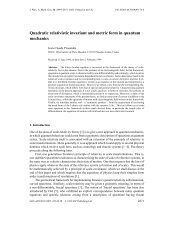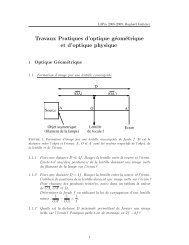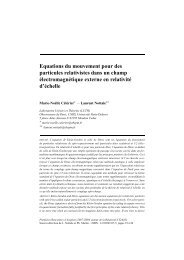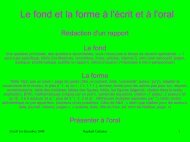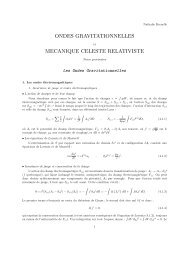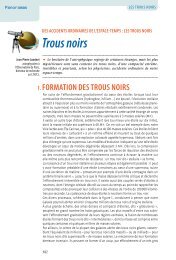EUROPEAN SCIENCE AWARDS - LUTh - Observatoire de Paris
EUROPEAN SCIENCE AWARDS - LUTh - Observatoire de Paris
EUROPEAN SCIENCE AWARDS - LUTh - Observatoire de Paris
Create successful ePaper yourself
Turn your PDF publications into a flip-book with our unique Google optimized e-Paper software.
SUCCESS STORIES<br />
<strong>EUROPEAN</strong><br />
<strong>SCIENCE</strong> <strong>AWARDS</strong><br />
2007<br />
Prize for Science<br />
Communication<br />
Marie Curie Awards<br />
Descartes Prize<br />
for Transnational<br />
Collaborative Research
Contents<br />
Science Communication Prize . . . . . . . . . . . . . . . . . . . . . . . . . . . . . . . . . . . . . . . . . . . . . . . . . . . . . . . . . . . . . . . . . . . . . 5<br />
Jean-Pierre Luminet Bringing black holes down to earth . . . . . . . . . . . . . . . . . . . . . . . . . . . . . . . . . . . . . . . . . . . . . . . . 6<br />
Delphine Grinberg Stimulating young minds . . . . . . . . . . . . . . . . . . . . . . . . . . . . . . . . . . . . . . . . . . . . . . . . . . . . . . . . . . . . . . 8<br />
Peter Leonard A cosmic conundrum . . . . . . . . . . . . . . . . . . . . . . . . . . . . . . . . . . . . . . . . . . . . . . . . . . . . . . . . . . . . . . . . . . . . . . . . 10<br />
Nuno Crato Mathematics for the people . . . . . . . . . . . . . . . . . . . . . . . . . . . . . . . . . . . . . . . . . . . . . . . . . . . . . . . . . . . . . . . . . . . . 12<br />
Maud Livrozet & Henri-Louis Poirier Getting insi<strong>de</strong> our body . . . . . . . . . . . . . . . . . . . . . . . . . . . . . . . . . . . . . . . . . . 13<br />
The Final Reviewers . . . . . . . . . . . . . . . . . . . . . . . . . . . . . . . . . . . . . . . . . . . . . . . . . . . . . . . . . . . . . . . . . . . . . . . . . . . . . . . . . . . . . . . . . . . . 15<br />
The Nominating Organisations . . . . . . . . . . . . . . . . . . . . . . . . . . . . . . . . . . . . . . . . . . . . . . . . . . . . . . . . . . . . . . . . . . . . . . . . . . . . . 17<br />
Marie Curie Awards . . . . . . . . . . . . . . . . . . . . . . . . . . . . . . . . . . . . . . . . . . . . . . . . . . . . . . . . . . . . . . . . . . . . . . . . . . . . . . . . . . . . . . 19<br />
Prof. Luisa Corrado Can money buy happiness? . . . . . . . . . . . . . . . . . . . . . . . . . . . . . . . . . . . . . . . . . . . . . . . . . . . . . . . . . . . 20<br />
Dr Batu Erman Targeting killer T-Cells for cancer . . . . . . . . . . . . . . . . . . . . . . . . . . . . . . . . . . . . . . . . . . . . . . . . . . . . . . . . . . . 22<br />
Dr Andrea C. Ferrari From nanotubes to new electronic <strong>de</strong>vices . . . . . . . . . . . . . . . . . . . . . . . . . . . . . . . . . . . . . . . 24<br />
Prof. Robert Nichol Shining light on dark energy . . . . . . . . . . . . . . . . . . . . . . . . . . . . . . . . . . . . . . . . . . . . . . . . . . . . . . . . . . 26<br />
Dr Valerie O’Donnell Radical route to inflammation . . . . . . . . . . . . . . . . . . . . . . . . . . . . . . . . . . . . . . . . . . . . . . . . . . . . . . 28<br />
Grand Jury Members . . . . . . . . . . . . . . . . . . . . . . . . . . . . . . . . . . . . . . . . . . . . . . . . . . . . . . . . . . . . . . . . . . . . . . . . . . . . . . . . . . . . . . . . . . 31<br />
Descartes Research Prize . . . . . . . . . . . . . . . . . . . . . . . . . . . . . . . . . . . . . . . . . . . . . . . . . . . . . . . . . . . . . . . . . . . . . . . . . . . . . 33<br />
VIRLIS Listeria research leads fight on infection . . . . . . . . . . . . . . . . . . . . . . . . . . . . . . . . . . . . . . . . . . . . . . . . . . . . . . . . . . . . . 34<br />
SynNanoMotors Marvellous molecular motors . . . . . . . . . . . . . . . . . . . . . . . . . . . . . . . . . . . . . . . . . . . . . . . . . . . . . . . . . . . . 36<br />
EPICA Ice cores reveal climate change clues . . . . . . . . . . . . . . . . . . . . . . . . . . . . . . . . . . . . . . . . . . . . . . . . . . . . . . . . . . . . . . . . 38<br />
Grand Jury Members . . . . . . . . . . . . . . . . . . . . . . . . . . . . . . . . . . . . . . . . . . . . . . . . . . . . . . . . . . . . . . . . . . . . . . . . . . . . . . . . . . . . . . . . . . 41<br />
3
Science<br />
Communication Prize<br />
Excellence in European science communication<br />
The Science Communication Prize was launched in 2004 by the European Commission’s<br />
Directorate-General for Research to help stimulating interest in science, promoting the<br />
un<strong>de</strong>rstanding of scientific progress, and its implications in wi<strong>de</strong>r society. The prize<br />
reflects the European Union’s aim to boost scientific culture, to support the communication<br />
of research results, and to encourage people to take on scientific careers.<br />
The Prize recognises and rewards high-quality and accurate science communication<br />
activities aimed at a general audience. Un<strong>de</strong>r the 2007 Science Communication Prize,<br />
three laureates will each receive € 60 000 and two finalists will both receive € 5 000.<br />
The Science Communication Prize targets organisations or individuals that have achieved<br />
outstanding results in science communication and have already been recognised with<br />
a prize or award by a European and/or national science communication prize organiser.<br />
There are three science communication prize categories:<br />
The Communicator of the Year<br />
The Writer of the Year<br />
The Audiovisual Documentary of the Year<br />
<br />
5
Laureate<br />
6<br />
Bringing black holes down to earth<br />
A world-class scientist who is also a best-selling author and an artist:<br />
Professor Jean-Pierre Luminet is a worthy champion of science and<br />
a science communicator of exceptional quality. His consi<strong>de</strong>rable<br />
literary production focuses on his own specialism, astronomy and<br />
cosmology, which he explores via a variety of media to communicate<br />
its fascinations to the general public and the younger generation.<br />
Whether working in print, on television, through exhibitions,<br />
music or the arts, he <strong>de</strong>livers accessible information of the highest<br />
quality and intelligence that speaks across cultures and values.<br />
Jean-Pierre Luminet is a true renaissance man. The Frenchman<br />
is a distinguished astrophysicist and Director of<br />
Research at the Centre National <strong>de</strong> la Recherche Scientifique,<br />
a renowned cosmologist at the <strong>Observatoire</strong> <strong>de</strong> <strong>Paris</strong>,<br />
Laboratoire Univers et Théories, as well as a poet, artist,<br />
communicator to the public and author of many varied<br />
multimedia productions.<br />
His recent book ‘Le <strong>de</strong>stin <strong>de</strong> l’univers: trous noirs et<br />
énergie sombre’ <strong>de</strong>alt with black holes and dark energy but<br />
was aimed squarely at the general public. It was praised for<br />
its outstanding scientific, historic, literary and esthetical<br />
qualities. In 2006, he also published ‘Le Secret <strong>de</strong> Copernic’,<br />
an essay on the astronomer Copernicus related in the style<br />
of a historical novel.<br />
A mo<strong>de</strong>l for communication<br />
Luminet’s publications for a general audience share a<br />
number of features that make them a mo<strong>de</strong>l for communicating<br />
science to the public. Their scientific content is<br />
rigorous and always up-to-date. He is not afraid to work in<br />
a diversity of publications and media: he has produced<br />
popular science books, historical novels, beautifully<br />
illustrated exhibition catalogues, multimedia productions<br />
for children and poetry. He is an artist, engraver and sculptor<br />
and has also collaborated with celebrated musicians.<br />
Luminet’s work has been translated into a wi<strong>de</strong> variety of<br />
languages including Chinese and Korean.<br />
His works provi<strong>de</strong> a <strong>de</strong>pth of pan-European cultural values.<br />
One of his most important contributions has been the<br />
re-evaluation and promotion, based on extensive historical<br />
and scientific research, of the Belgian priest and cosmologist<br />
George Lemaître. Lemaître pioneered the application of<br />
Einstein’s general theory of relativity to cosmology, suggested<br />
a pre-cursor of the law now named after the American Edwin<br />
Hubble, and proposed the first ‘Big Bang’ theory.<br />
In 2006, Jean-Pierre Luminet was awar<strong>de</strong>d the highly coveted<br />
‘Prix Doisteau-Blutet <strong>de</strong> l’information scientifique et<br />
technique’ by the French Académie <strong>de</strong>s Sciences. And it is<br />
the Académie who has nominated him for the European<br />
Science Communication Prize.<br />
In its award, Jules Hoffman, Presi<strong>de</strong>nt of the Académie <strong>de</strong>s<br />
Sciences, <strong>de</strong>scribes Luminet as a talented astrophysicist<br />
who also “has an exceptional literary talent and uses his<br />
creativity to communicate the current results of his field to the<br />
public as well as <strong>de</strong>cision-makers in the world of economics,<br />
thus contributing to better integration of science in our<br />
society.”<br />
The scientist<br />
Luminet’s main research areas involve the space-time<br />
structure of the universe that is <strong>de</strong>scribed by Einstein’s<br />
general theory of relativity and its subsequent <strong>de</strong>velopments.<br />
His main interests are on three scales: the infinitely<br />
small such as singularities – for example in the centre of<br />
black holes; the macroscopic scale such as black holes and<br />
their immediate environment; and at the cosmological<br />
scale including universal topology, problems in space-time.<br />
Luminet has published over 60 scientific papers.<br />
Having completed a doctoral thesis on singularities in the<br />
solutions of general relativity equations at Université <strong>de</strong> <strong>Paris</strong>,<br />
Luminet spent several years researching black holes. His first<br />
major contribution was the simulation in 1979 of the optical<br />
distortions that would be caused by the intense gravitational<br />
field of a black hole. It should be noted that this work was<br />
carried out without the aid of mo<strong>de</strong>rn computer tools.<br />
In 1982, he was one of the first to study the effects of a star<br />
passing close to a super-massive black hole. A particular<br />
phenomenon that the work predicted was the <strong>de</strong>struction<br />
of a passing star due to strong gravitational tidal effects of<br />
the black hole producing a specific ‘signature’ from within<br />
distant galaxies. This signal was observed some twenty<br />
years later by the Chandra and XMM-Newton satellite<br />
telescopes in 2004.
© Jeffrey Weeks<br />
Jean-Pierre Luminet Communicator of the Year<br />
A wraparound universe<br />
Since 1995, Luminet has been involved in cosmic topology<br />
in collaboration with numerous colleagues. He <strong>de</strong>fined the<br />
concept that the universe might be spatially finite but<br />
without a <strong>de</strong>finitive outer rim in his ‘univers chiffonné’<br />
(wraparound universe) proposal. In 2003, following analysis<br />
of anomalies in the WMAP satellite data on the cosmic<br />
background radiation, he further proposed that the universe<br />
was positively curved with the same shape as a do<strong>de</strong>cahedron<br />
– a twelve-si<strong>de</strong>d polygon.<br />
Luminet also finds time to study cybernetics, epistemology<br />
(the theory of knowledge) and the history of science in<br />
addition to his varied cultural activities.<br />
Luminet <strong>de</strong>scribes his own philosophy as follows: “I have<br />
always believed in the links between the various forms of<br />
human creation. In fact, different approaches – whether<br />
scientific, aesthetic, philosophical or other – give rise to<br />
different perceptions of the world, but with an un<strong>de</strong>rlying<br />
common imaginary element.”<br />
The impact of Luminet’s communication work is consi<strong>de</strong>rable,<br />
in particular in French-speaking and European society. He<br />
has an ability to give a clear and historical vision of the<br />
fundamental contribution of European scientists to<br />
astronomy and our un<strong>de</strong>rstanding of the Universe over<br />
some 25 centuries. In this manner he serves to illuminate<br />
the richness of European culture and the clear place of<br />
science within it.<br />
In conclusion, it is hard to find in Europe today a science<br />
communicator who has reached the breadth, quality and<br />
quantity of production of Luminet. He has highlighted the<br />
intimate presence of European discoveries in the remote<br />
and recent past for the public, and contributed significantly<br />
to that body of scientific work.<br />
INFO<br />
Jean-Pierre Luminet<br />
Category<br />
Communicator of the Year<br />
Contact<br />
Prof. Jean-Pierre Luminet<br />
E-mail: Jean-pierre.luminet@obspm.fr<br />
Website<br />
http://luth2.obspm.fr/luminet.html<br />
2007<br />
Communication Prize<br />
7




